Analyzing the Relationship Between Oil Prices and Stock Market Trends
VerifiedAdded on 2019/11/25
|10
|2214
|245
Report
AI Summary
This report investigates the relationship between oil prices and stock markets, identifying them as leading economic indicators. It explores how fluctuations in oil prices impact corporate cash flows, earnings, and ultimately, stock prices. The report aims to analyze the effects of price changes over the past years, focusing on volatility spillovers, bidirectional impacts, and regional economic effects in North America, Western Europe, and OPEC countries. The methodology employs a qualitative research approach using secondary data to analyze trends and correlations. The report includes a literature review discussing the volatility of oil prices, the relationship between oil prices and economic growth, and volatility spillovers within the stock market. The data analysis will use thematic analysis to identify key themes and patterns, followed by the conclusion summarizing the significant findings and implications for the global economy and stock market operations. A Gantt chart is included to provide a timeline for the research process.
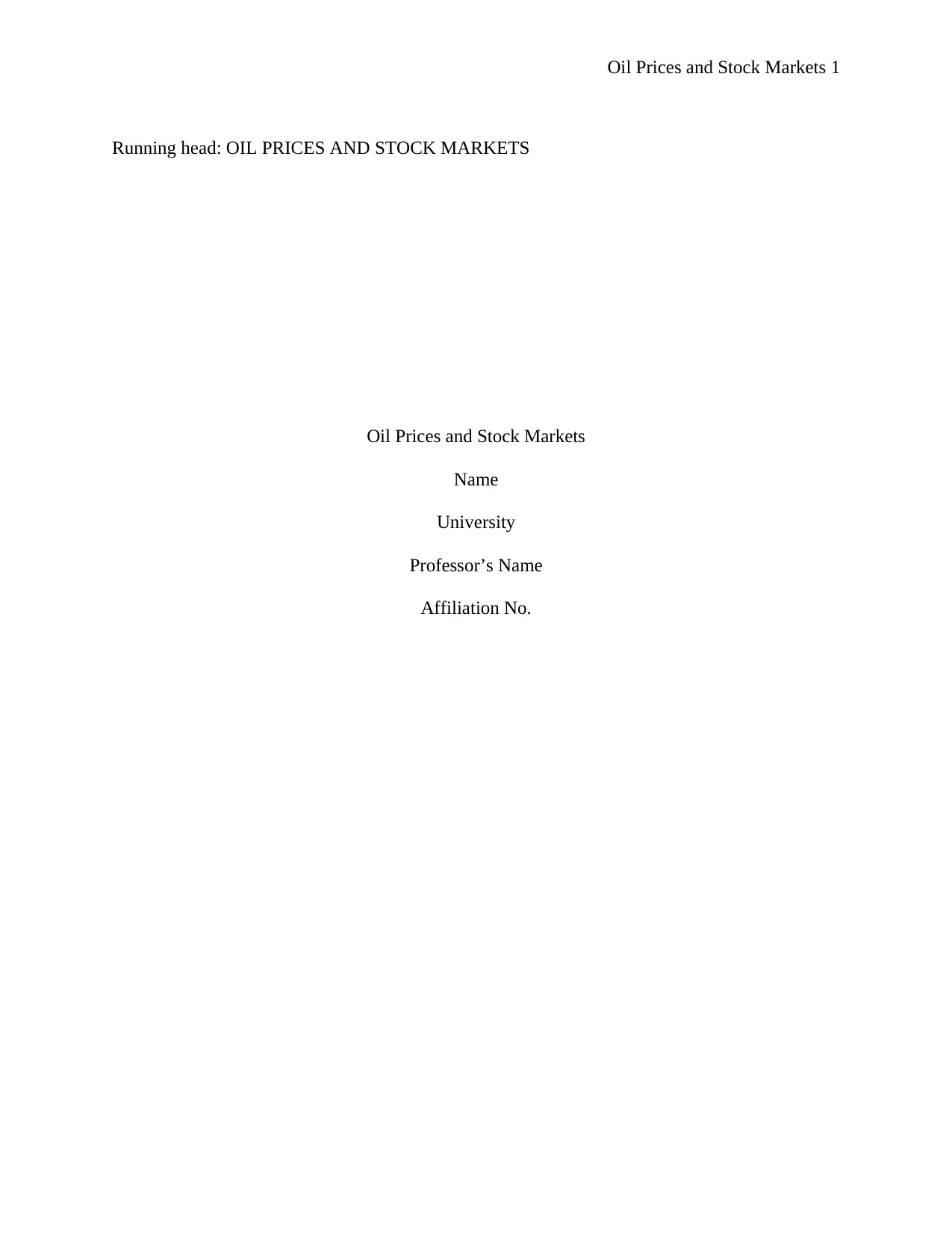
Oil Prices and Stock Markets 1
Running head: OIL PRICES AND STOCK MARKETS
Oil Prices and Stock Markets
Name
University
Professor’s Name
Affiliation No.
Running head: OIL PRICES AND STOCK MARKETS
Oil Prices and Stock Markets
Name
University
Professor’s Name
Affiliation No.
Paraphrase This Document
Need a fresh take? Get an instant paraphrase of this document with our AI Paraphraser
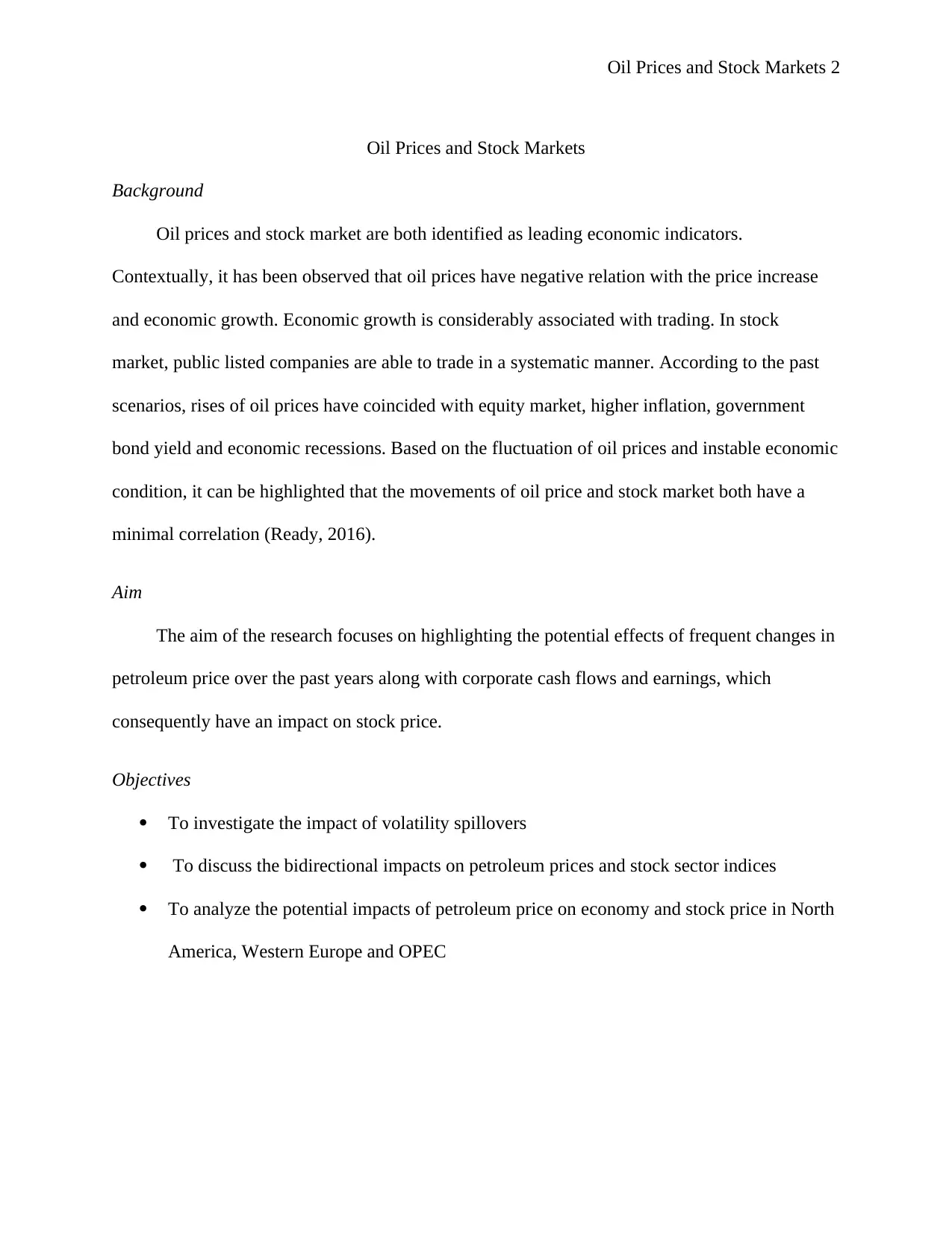
Oil Prices and Stock Markets 2
Oil Prices and Stock Markets
Background
Oil prices and stock market are both identified as leading economic indicators.
Contextually, it has been observed that oil prices have negative relation with the price increase
and economic growth. Economic growth is considerably associated with trading. In stock
market, public listed companies are able to trade in a systematic manner. According to the past
scenarios, rises of oil prices have coincided with equity market, higher inflation, government
bond yield and economic recessions. Based on the fluctuation of oil prices and instable economic
condition, it can be highlighted that the movements of oil price and stock market both have a
minimal correlation (Ready, 2016).
Aim
The aim of the research focuses on highlighting the potential effects of frequent changes in
petroleum price over the past years along with corporate cash flows and earnings, which
consequently have an impact on stock price.
Objectives
To investigate the impact of volatility spillovers
To discuss the bidirectional impacts on petroleum prices and stock sector indices
To analyze the potential impacts of petroleum price on economy and stock price in North
America, Western Europe and OPEC
Oil Prices and Stock Markets
Background
Oil prices and stock market are both identified as leading economic indicators.
Contextually, it has been observed that oil prices have negative relation with the price increase
and economic growth. Economic growth is considerably associated with trading. In stock
market, public listed companies are able to trade in a systematic manner. According to the past
scenarios, rises of oil prices have coincided with equity market, higher inflation, government
bond yield and economic recessions. Based on the fluctuation of oil prices and instable economic
condition, it can be highlighted that the movements of oil price and stock market both have a
minimal correlation (Ready, 2016).
Aim
The aim of the research focuses on highlighting the potential effects of frequent changes in
petroleum price over the past years along with corporate cash flows and earnings, which
consequently have an impact on stock price.
Objectives
To investigate the impact of volatility spillovers
To discuss the bidirectional impacts on petroleum prices and stock sector indices
To analyze the potential impacts of petroleum price on economy and stock price in North
America, Western Europe and OPEC
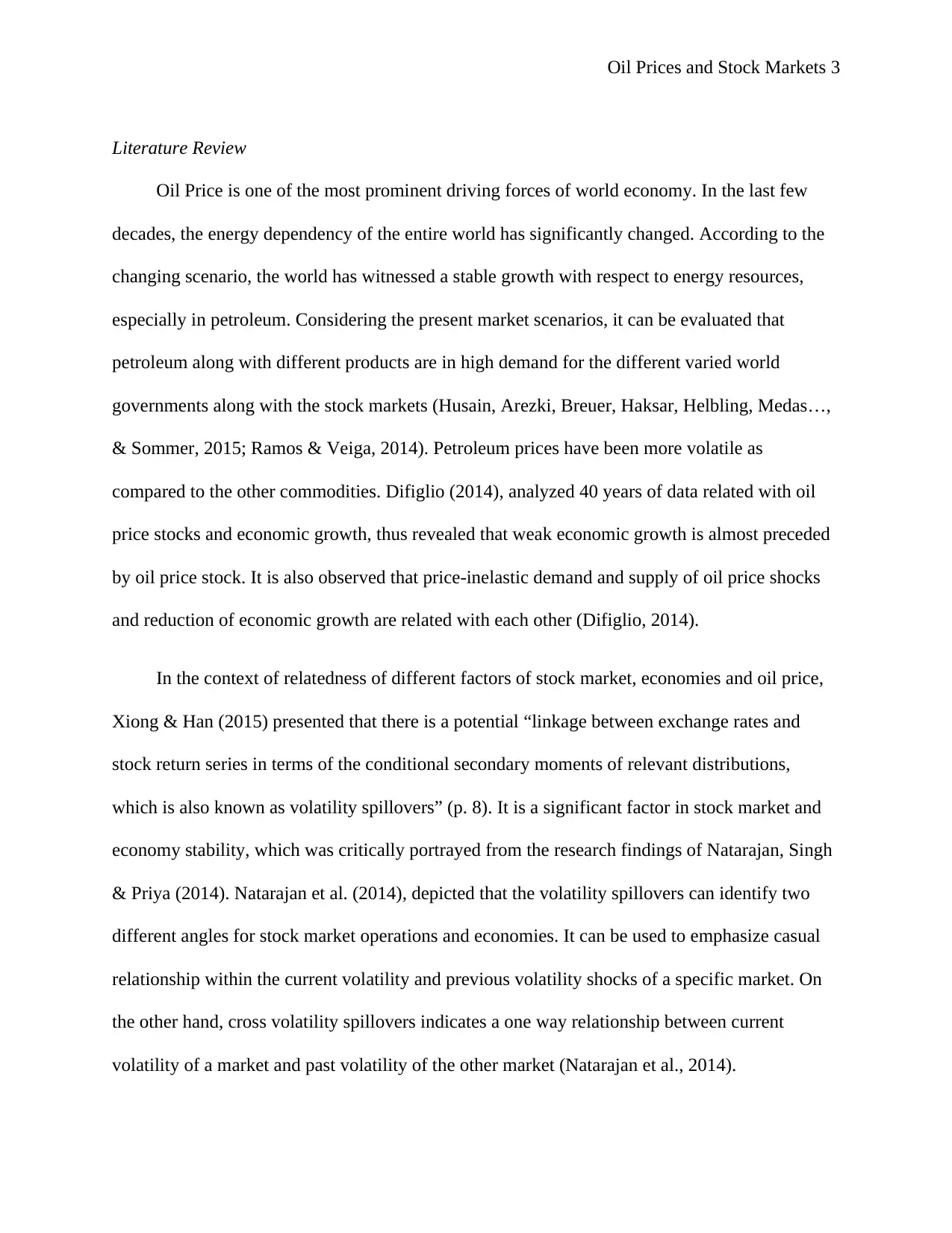
Oil Prices and Stock Markets 3
Literature Review
Oil Price is one of the most prominent driving forces of world economy. In the last few
decades, the energy dependency of the entire world has significantly changed. According to the
changing scenario, the world has witnessed a stable growth with respect to energy resources,
especially in petroleum. Considering the present market scenarios, it can be evaluated that
petroleum along with different products are in high demand for the different varied world
governments along with the stock markets (Husain, Arezki, Breuer, Haksar, Helbling, Medas…,
& Sommer, 2015; Ramos & Veiga, 2014). Petroleum prices have been more volatile as
compared to the other commodities. Difiglio (2014), analyzed 40 years of data related with oil
price stocks and economic growth, thus revealed that weak economic growth is almost preceded
by oil price stock. It is also observed that price-inelastic demand and supply of oil price shocks
and reduction of economic growth are related with each other (Difiglio, 2014).
In the context of relatedness of different factors of stock market, economies and oil price,
Xiong & Han (2015) presented that there is a potential “linkage between exchange rates and
stock return series in terms of the conditional secondary moments of relevant distributions,
which is also known as volatility spillovers” (p. 8). It is a significant factor in stock market and
economy stability, which was critically portrayed from the research findings of Natarajan, Singh
& Priya (2014). Natarajan et al. (2014), depicted that the volatility spillovers can identify two
different angles for stock market operations and economies. It can be used to emphasize casual
relationship within the current volatility and previous volatility shocks of a specific market. On
the other hand, cross volatility spillovers indicates a one way relationship between current
volatility of a market and past volatility of the other market (Natarajan et al., 2014).
Literature Review
Oil Price is one of the most prominent driving forces of world economy. In the last few
decades, the energy dependency of the entire world has significantly changed. According to the
changing scenario, the world has witnessed a stable growth with respect to energy resources,
especially in petroleum. Considering the present market scenarios, it can be evaluated that
petroleum along with different products are in high demand for the different varied world
governments along with the stock markets (Husain, Arezki, Breuer, Haksar, Helbling, Medas…,
& Sommer, 2015; Ramos & Veiga, 2014). Petroleum prices have been more volatile as
compared to the other commodities. Difiglio (2014), analyzed 40 years of data related with oil
price stocks and economic growth, thus revealed that weak economic growth is almost preceded
by oil price stock. It is also observed that price-inelastic demand and supply of oil price shocks
and reduction of economic growth are related with each other (Difiglio, 2014).
In the context of relatedness of different factors of stock market, economies and oil price,
Xiong & Han (2015) presented that there is a potential “linkage between exchange rates and
stock return series in terms of the conditional secondary moments of relevant distributions,
which is also known as volatility spillovers” (p. 8). It is a significant factor in stock market and
economy stability, which was critically portrayed from the research findings of Natarajan, Singh
& Priya (2014). Natarajan et al. (2014), depicted that the volatility spillovers can identify two
different angles for stock market operations and economies. It can be used to emphasize casual
relationship within the current volatility and previous volatility shocks of a specific market. On
the other hand, cross volatility spillovers indicates a one way relationship between current
volatility of a market and past volatility of the other market (Natarajan et al., 2014).
⊘ This is a preview!⊘
Do you want full access?
Subscribe today to unlock all pages.

Trusted by 1+ million students worldwide
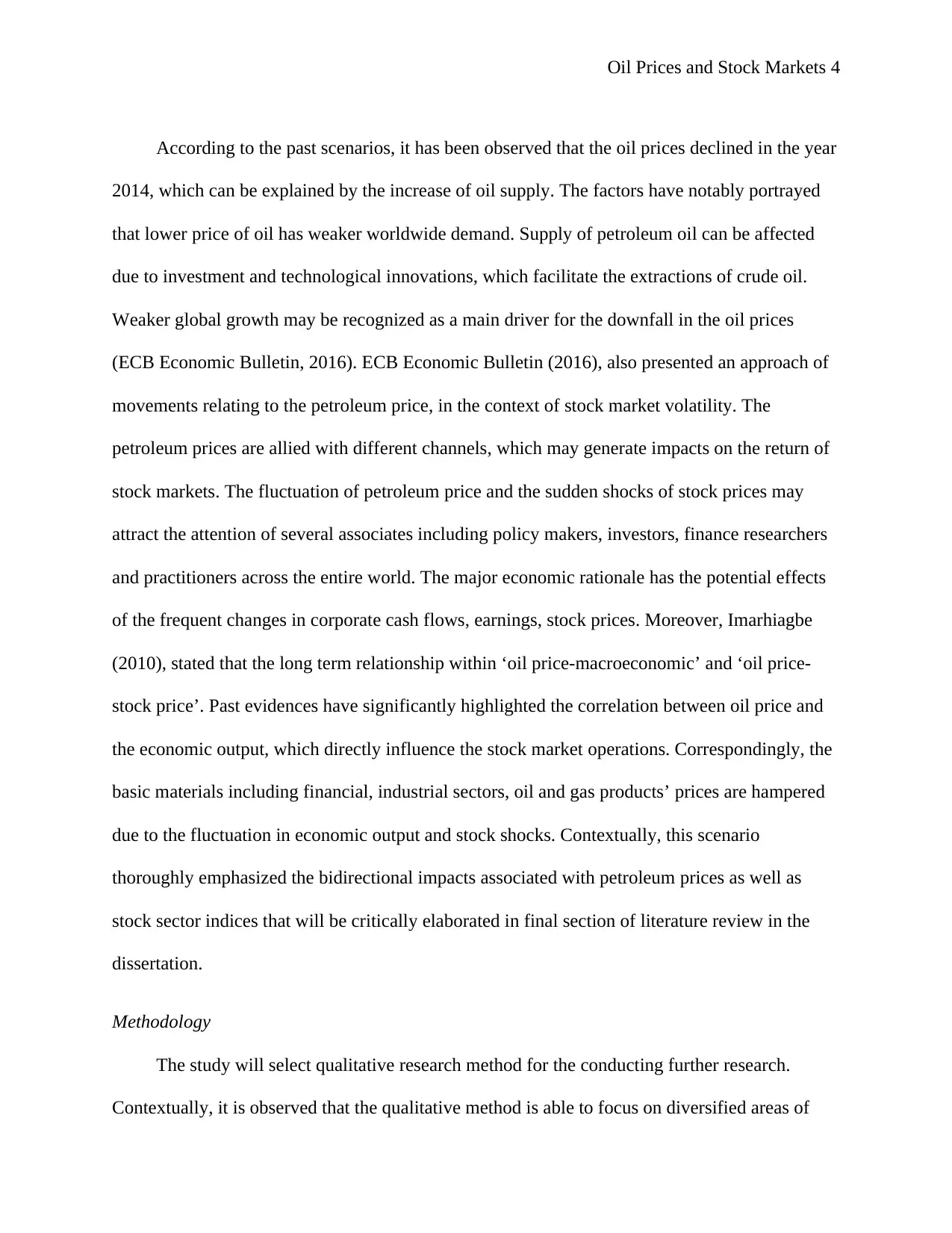
Oil Prices and Stock Markets 4
According to the past scenarios, it has been observed that the oil prices declined in the year
2014, which can be explained by the increase of oil supply. The factors have notably portrayed
that lower price of oil has weaker worldwide demand. Supply of petroleum oil can be affected
due to investment and technological innovations, which facilitate the extractions of crude oil.
Weaker global growth may be recognized as a main driver for the downfall in the oil prices
(ECB Economic Bulletin, 2016). ECB Economic Bulletin (2016), also presented an approach of
movements relating to the petroleum price, in the context of stock market volatility. The
petroleum prices are allied with different channels, which may generate impacts on the return of
stock markets. The fluctuation of petroleum price and the sudden shocks of stock prices may
attract the attention of several associates including policy makers, investors, finance researchers
and practitioners across the entire world. The major economic rationale has the potential effects
of the frequent changes in corporate cash flows, earnings, stock prices. Moreover, Imarhiagbe
(2010), stated that the long term relationship within ‘oil price-macroeconomic’ and ‘oil price-
stock price’. Past evidences have significantly highlighted the correlation between oil price and
the economic output, which directly influence the stock market operations. Correspondingly, the
basic materials including financial, industrial sectors, oil and gas products’ prices are hampered
due to the fluctuation in economic output and stock shocks. Contextually, this scenario
thoroughly emphasized the bidirectional impacts associated with petroleum prices as well as
stock sector indices that will be critically elaborated in final section of literature review in the
dissertation.
Methodology
The study will select qualitative research method for the conducting further research.
Contextually, it is observed that the qualitative method is able to focus on diversified areas of
According to the past scenarios, it has been observed that the oil prices declined in the year
2014, which can be explained by the increase of oil supply. The factors have notably portrayed
that lower price of oil has weaker worldwide demand. Supply of petroleum oil can be affected
due to investment and technological innovations, which facilitate the extractions of crude oil.
Weaker global growth may be recognized as a main driver for the downfall in the oil prices
(ECB Economic Bulletin, 2016). ECB Economic Bulletin (2016), also presented an approach of
movements relating to the petroleum price, in the context of stock market volatility. The
petroleum prices are allied with different channels, which may generate impacts on the return of
stock markets. The fluctuation of petroleum price and the sudden shocks of stock prices may
attract the attention of several associates including policy makers, investors, finance researchers
and practitioners across the entire world. The major economic rationale has the potential effects
of the frequent changes in corporate cash flows, earnings, stock prices. Moreover, Imarhiagbe
(2010), stated that the long term relationship within ‘oil price-macroeconomic’ and ‘oil price-
stock price’. Past evidences have significantly highlighted the correlation between oil price and
the economic output, which directly influence the stock market operations. Correspondingly, the
basic materials including financial, industrial sectors, oil and gas products’ prices are hampered
due to the fluctuation in economic output and stock shocks. Contextually, this scenario
thoroughly emphasized the bidirectional impacts associated with petroleum prices as well as
stock sector indices that will be critically elaborated in final section of literature review in the
dissertation.
Methodology
The study will select qualitative research method for the conducting further research.
Contextually, it is observed that the qualitative method is able to focus on diversified areas of
Paraphrase This Document
Need a fresh take? Get an instant paraphrase of this document with our AI Paraphraser
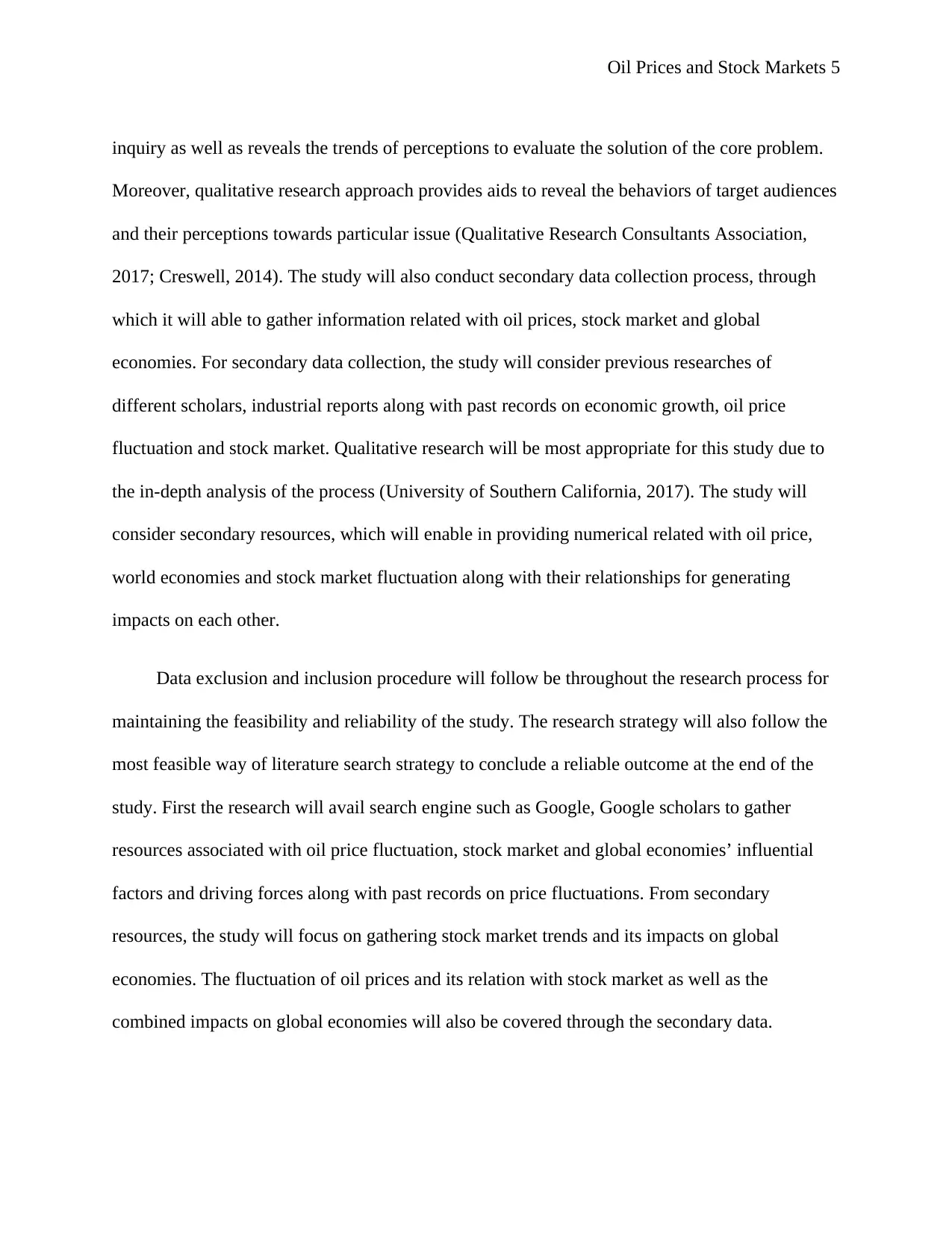
Oil Prices and Stock Markets 5
inquiry as well as reveals the trends of perceptions to evaluate the solution of the core problem.
Moreover, qualitative research approach provides aids to reveal the behaviors of target audiences
and their perceptions towards particular issue (Qualitative Research Consultants Association,
2017; Creswell, 2014). The study will also conduct secondary data collection process, through
which it will able to gather information related with oil prices, stock market and global
economies. For secondary data collection, the study will consider previous researches of
different scholars, industrial reports along with past records on economic growth, oil price
fluctuation and stock market. Qualitative research will be most appropriate for this study due to
the in-depth analysis of the process (University of Southern California, 2017). The study will
consider secondary resources, which will enable in providing numerical related with oil price,
world economies and stock market fluctuation along with their relationships for generating
impacts on each other.
Data exclusion and inclusion procedure will follow be throughout the research process for
maintaining the feasibility and reliability of the study. The research strategy will also follow the
most feasible way of literature search strategy to conclude a reliable outcome at the end of the
study. First the research will avail search engine such as Google, Google scholars to gather
resources associated with oil price fluctuation, stock market and global economies’ influential
factors and driving forces along with past records on price fluctuations. From secondary
resources, the study will focus on gathering stock market trends and its impacts on global
economies. The fluctuation of oil prices and its relation with stock market as well as the
combined impacts on global economies will also be covered through the secondary data.
inquiry as well as reveals the trends of perceptions to evaluate the solution of the core problem.
Moreover, qualitative research approach provides aids to reveal the behaviors of target audiences
and their perceptions towards particular issue (Qualitative Research Consultants Association,
2017; Creswell, 2014). The study will also conduct secondary data collection process, through
which it will able to gather information related with oil prices, stock market and global
economies. For secondary data collection, the study will consider previous researches of
different scholars, industrial reports along with past records on economic growth, oil price
fluctuation and stock market. Qualitative research will be most appropriate for this study due to
the in-depth analysis of the process (University of Southern California, 2017). The study will
consider secondary resources, which will enable in providing numerical related with oil price,
world economies and stock market fluctuation along with their relationships for generating
impacts on each other.
Data exclusion and inclusion procedure will follow be throughout the research process for
maintaining the feasibility and reliability of the study. The research strategy will also follow the
most feasible way of literature search strategy to conclude a reliable outcome at the end of the
study. First the research will avail search engine such as Google, Google scholars to gather
resources associated with oil price fluctuation, stock market and global economies’ influential
factors and driving forces along with past records on price fluctuations. From secondary
resources, the study will focus on gathering stock market trends and its impacts on global
economies. The fluctuation of oil prices and its relation with stock market as well as the
combined impacts on global economies will also be covered through the secondary data.
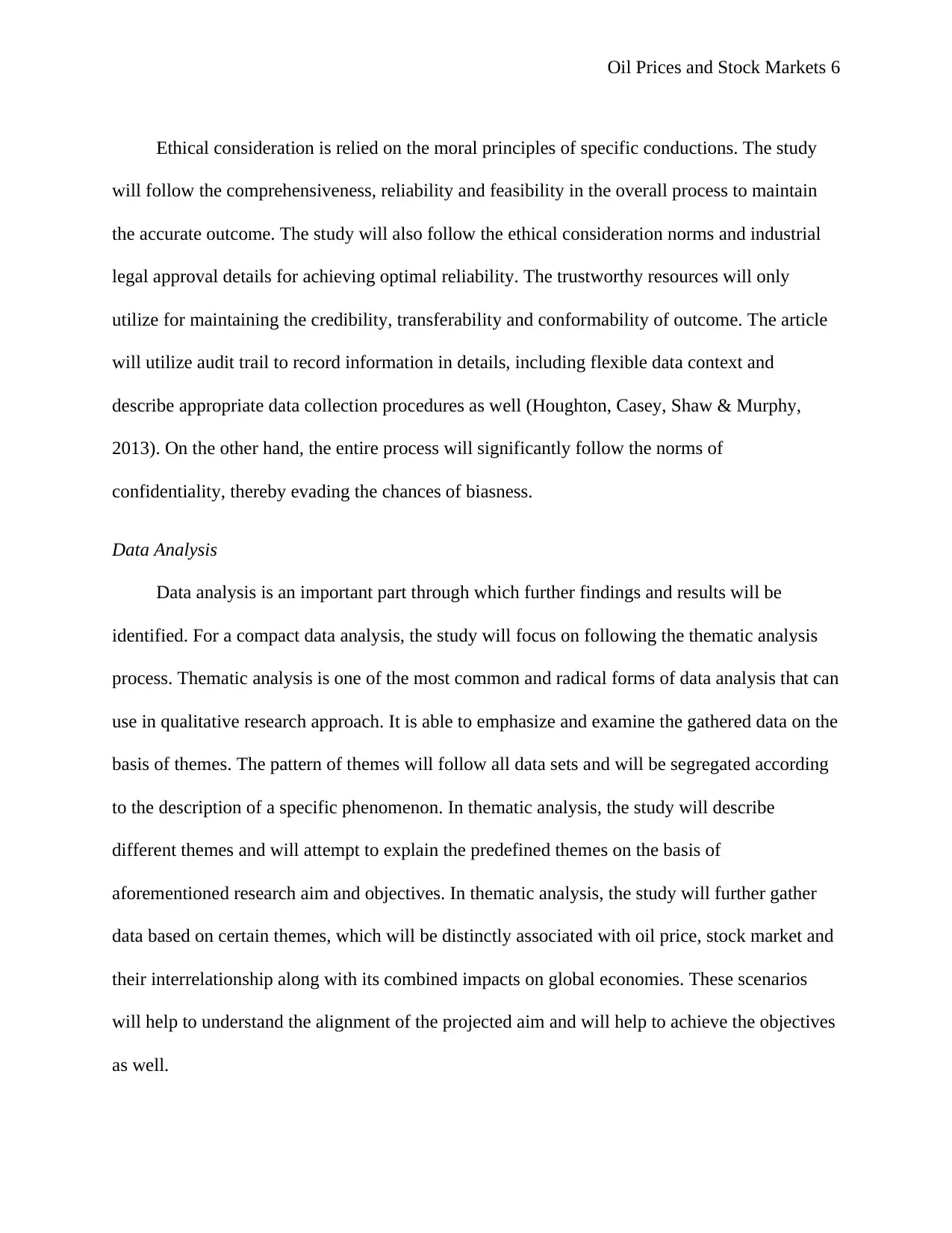
Oil Prices and Stock Markets 6
Ethical consideration is relied on the moral principles of specific conductions. The study
will follow the comprehensiveness, reliability and feasibility in the overall process to maintain
the accurate outcome. The study will also follow the ethical consideration norms and industrial
legal approval details for achieving optimal reliability. The trustworthy resources will only
utilize for maintaining the credibility, transferability and conformability of outcome. The article
will utilize audit trail to record information in details, including flexible data context and
describe appropriate data collection procedures as well (Houghton, Casey, Shaw & Murphy,
2013). On the other hand, the entire process will significantly follow the norms of
confidentiality, thereby evading the chances of biasness.
Data Analysis
Data analysis is an important part through which further findings and results will be
identified. For a compact data analysis, the study will focus on following the thematic analysis
process. Thematic analysis is one of the most common and radical forms of data analysis that can
use in qualitative research approach. It is able to emphasize and examine the gathered data on the
basis of themes. The pattern of themes will follow all data sets and will be segregated according
to the description of a specific phenomenon. In thematic analysis, the study will describe
different themes and will attempt to explain the predefined themes on the basis of
aforementioned research aim and objectives. In thematic analysis, the study will further gather
data based on certain themes, which will be distinctly associated with oil price, stock market and
their interrelationship along with its combined impacts on global economies. These scenarios
will help to understand the alignment of the projected aim and will help to achieve the objectives
as well.
Ethical consideration is relied on the moral principles of specific conductions. The study
will follow the comprehensiveness, reliability and feasibility in the overall process to maintain
the accurate outcome. The study will also follow the ethical consideration norms and industrial
legal approval details for achieving optimal reliability. The trustworthy resources will only
utilize for maintaining the credibility, transferability and conformability of outcome. The article
will utilize audit trail to record information in details, including flexible data context and
describe appropriate data collection procedures as well (Houghton, Casey, Shaw & Murphy,
2013). On the other hand, the entire process will significantly follow the norms of
confidentiality, thereby evading the chances of biasness.
Data Analysis
Data analysis is an important part through which further findings and results will be
identified. For a compact data analysis, the study will focus on following the thematic analysis
process. Thematic analysis is one of the most common and radical forms of data analysis that can
use in qualitative research approach. It is able to emphasize and examine the gathered data on the
basis of themes. The pattern of themes will follow all data sets and will be segregated according
to the description of a specific phenomenon. In thematic analysis, the study will describe
different themes and will attempt to explain the predefined themes on the basis of
aforementioned research aim and objectives. In thematic analysis, the study will further gather
data based on certain themes, which will be distinctly associated with oil price, stock market and
their interrelationship along with its combined impacts on global economies. These scenarios
will help to understand the alignment of the projected aim and will help to achieve the objectives
as well.
⊘ This is a preview!⊘
Do you want full access?
Subscribe today to unlock all pages.

Trusted by 1+ million students worldwide
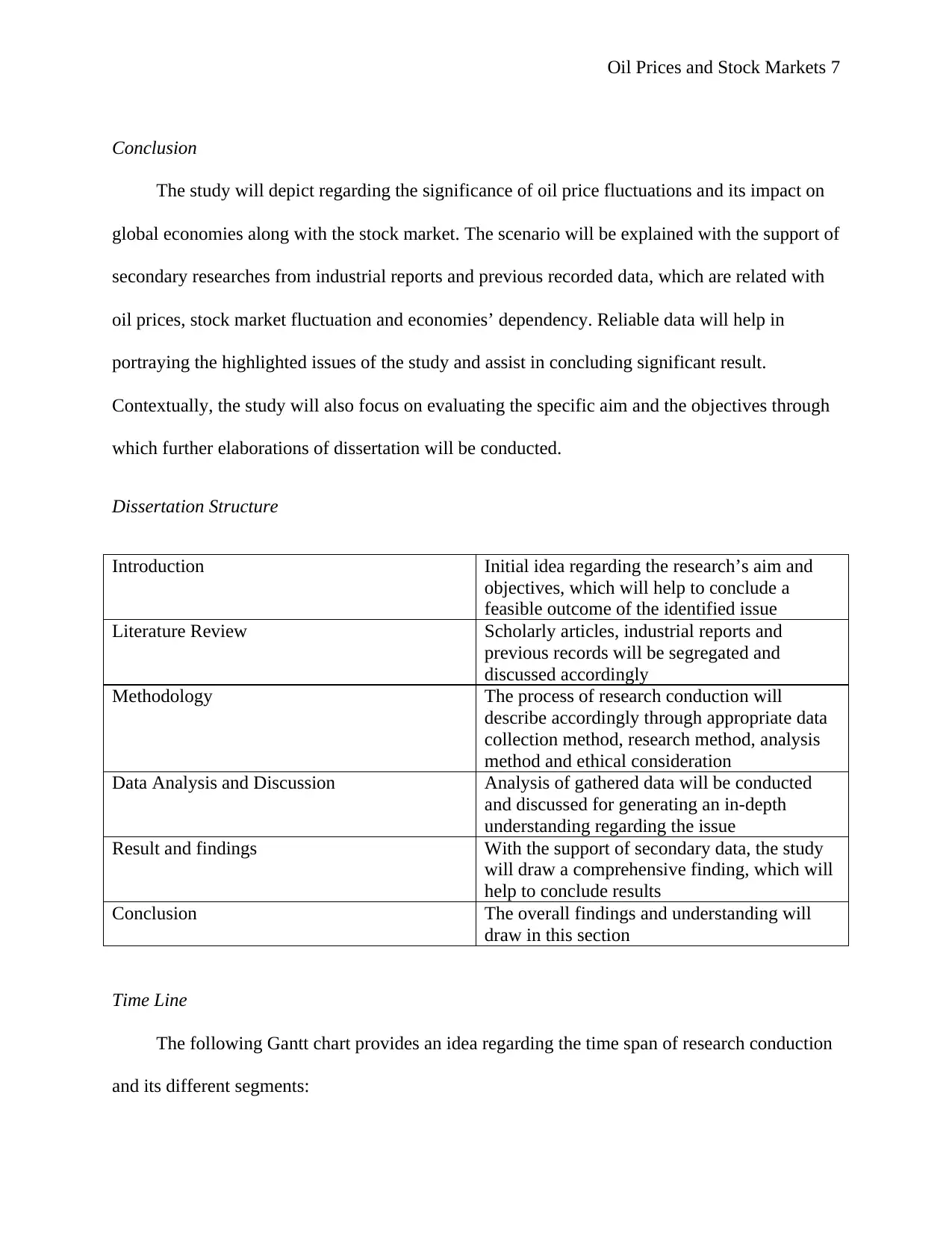
Oil Prices and Stock Markets 7
Conclusion
The study will depict regarding the significance of oil price fluctuations and its impact on
global economies along with the stock market. The scenario will be explained with the support of
secondary researches from industrial reports and previous recorded data, which are related with
oil prices, stock market fluctuation and economies’ dependency. Reliable data will help in
portraying the highlighted issues of the study and assist in concluding significant result.
Contextually, the study will also focus on evaluating the specific aim and the objectives through
which further elaborations of dissertation will be conducted.
Dissertation Structure
Introduction Initial idea regarding the research’s aim and
objectives, which will help to conclude a
feasible outcome of the identified issue
Literature Review Scholarly articles, industrial reports and
previous records will be segregated and
discussed accordingly
Methodology The process of research conduction will
describe accordingly through appropriate data
collection method, research method, analysis
method and ethical consideration
Data Analysis and Discussion Analysis of gathered data will be conducted
and discussed for generating an in-depth
understanding regarding the issue
Result and findings With the support of secondary data, the study
will draw a comprehensive finding, which will
help to conclude results
Conclusion The overall findings and understanding will
draw in this section
Time Line
The following Gantt chart provides an idea regarding the time span of research conduction
and its different segments:
Conclusion
The study will depict regarding the significance of oil price fluctuations and its impact on
global economies along with the stock market. The scenario will be explained with the support of
secondary researches from industrial reports and previous recorded data, which are related with
oil prices, stock market fluctuation and economies’ dependency. Reliable data will help in
portraying the highlighted issues of the study and assist in concluding significant result.
Contextually, the study will also focus on evaluating the specific aim and the objectives through
which further elaborations of dissertation will be conducted.
Dissertation Structure
Introduction Initial idea regarding the research’s aim and
objectives, which will help to conclude a
feasible outcome of the identified issue
Literature Review Scholarly articles, industrial reports and
previous records will be segregated and
discussed accordingly
Methodology The process of research conduction will
describe accordingly through appropriate data
collection method, research method, analysis
method and ethical consideration
Data Analysis and Discussion Analysis of gathered data will be conducted
and discussed for generating an in-depth
understanding regarding the issue
Result and findings With the support of secondary data, the study
will draw a comprehensive finding, which will
help to conclude results
Conclusion The overall findings and understanding will
draw in this section
Time Line
The following Gantt chart provides an idea regarding the time span of research conduction
and its different segments:
Paraphrase This Document
Need a fresh take? Get an instant paraphrase of this document with our AI Paraphraser
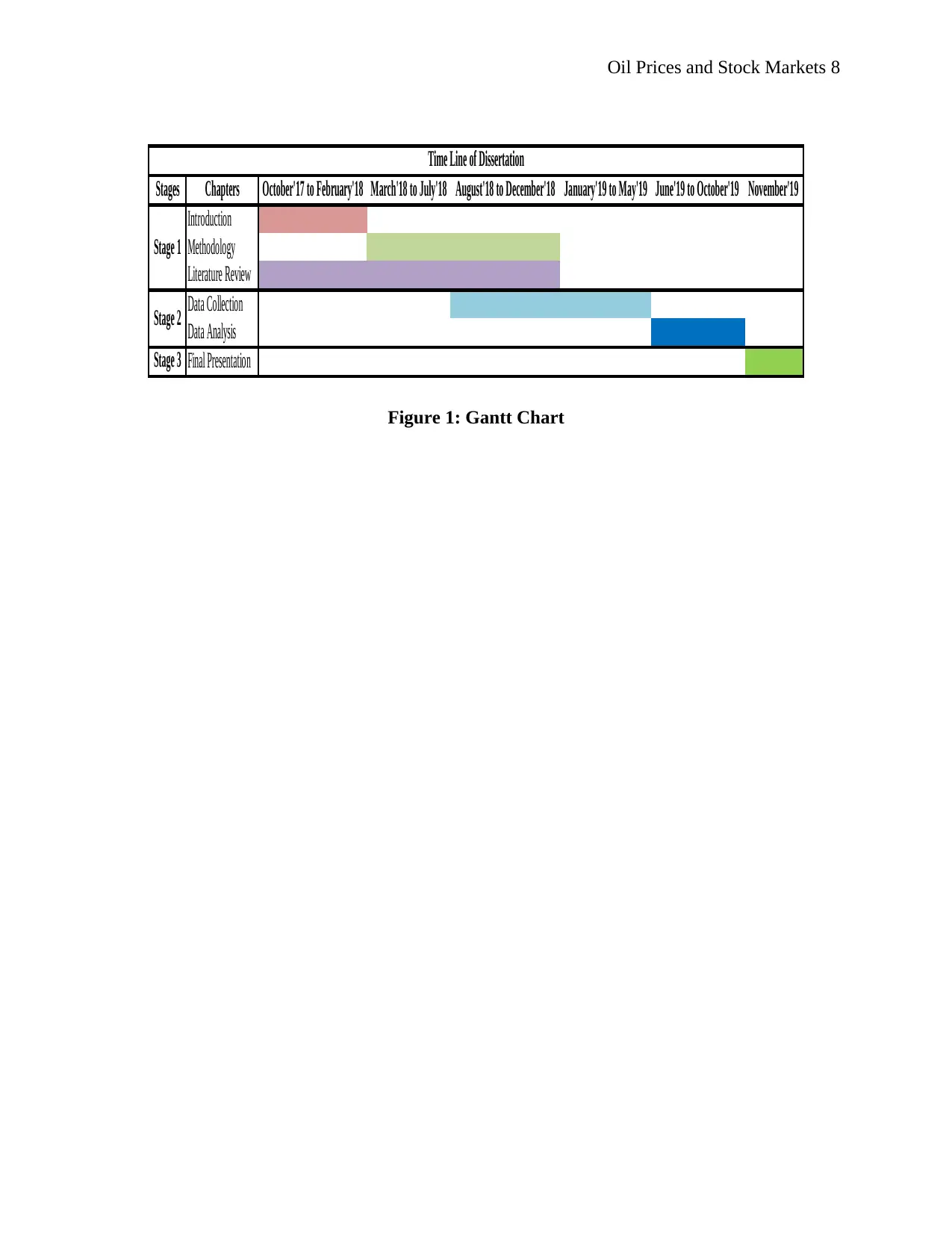
Oil Prices and Stock Markets 8
Stages Chapters October'17 to February'18 March'18 to July'18 August'18 to December'18 January'19 to May'19 June'19 to October'19 November'19
Introduction
Methodology
Literature Review
Data Collection
Data Analysis
Stage 3 Final Presentation
Stage 1
Stage 2
Time Line of Dissertation
Figure 1: Gantt Chart
Stages Chapters October'17 to February'18 March'18 to July'18 August'18 to December'18 January'19 to May'19 June'19 to October'19 November'19
Introduction
Methodology
Literature Review
Data Collection
Data Analysis
Stage 3 Final Presentation
Stage 1
Stage 2
Time Line of Dissertation
Figure 1: Gantt Chart
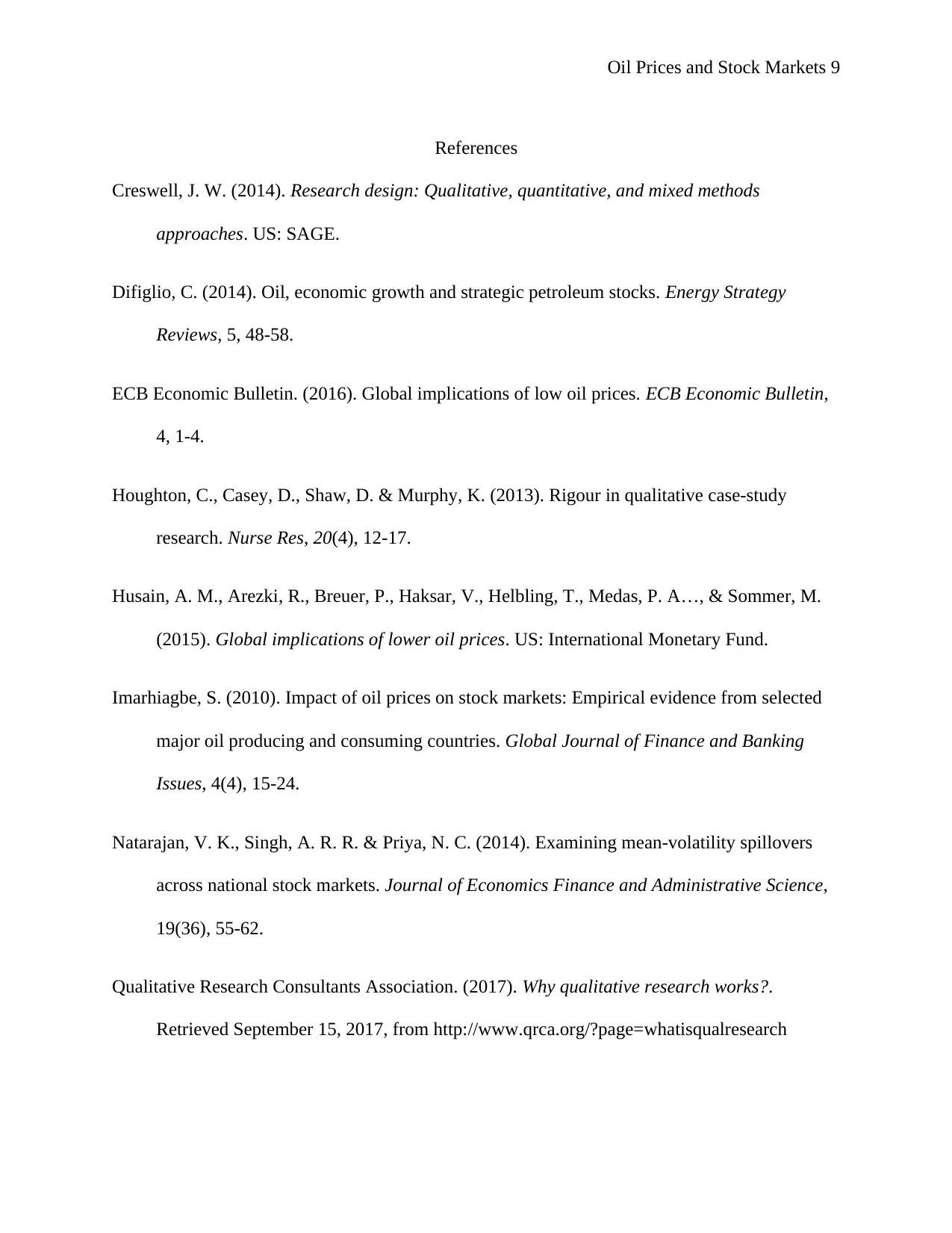
Oil Prices and Stock Markets 9
References
Creswell, J. W. (2014). Research design: Qualitative, quantitative, and mixed methods
approaches. US: SAGE.
Difiglio, C. (2014). Oil, economic growth and strategic petroleum stocks. Energy Strategy
Reviews, 5, 48-58.
ECB Economic Bulletin. (2016). Global implications of low oil prices. ECB Economic Bulletin,
4, 1-4.
Houghton, C., Casey, D., Shaw, D. & Murphy, K. (2013). Rigour in qualitative case-study
research. Nurse Res, 20(4), 12-17.
Husain, A. M., Arezki, R., Breuer, P., Haksar, V., Helbling, T., Medas, P. A…, & Sommer, M.
(2015). Global implications of lower oil prices. US: International Monetary Fund.
Imarhiagbe, S. (2010). Impact of oil prices on stock markets: Empirical evidence from selected
major oil producing and consuming countries. Global Journal of Finance and Banking
Issues, 4(4), 15-24.
Natarajan, V. K., Singh, A. R. R. & Priya, N. C. (2014). Examining mean-volatility spillovers
across national stock markets. Journal of Economics Finance and Administrative Science,
19(36), 55-62.
Qualitative Research Consultants Association. (2017). Why qualitative research works?.
Retrieved September 15, 2017, from http://www.qrca.org/?page=whatisqualresearch
References
Creswell, J. W. (2014). Research design: Qualitative, quantitative, and mixed methods
approaches. US: SAGE.
Difiglio, C. (2014). Oil, economic growth and strategic petroleum stocks. Energy Strategy
Reviews, 5, 48-58.
ECB Economic Bulletin. (2016). Global implications of low oil prices. ECB Economic Bulletin,
4, 1-4.
Houghton, C., Casey, D., Shaw, D. & Murphy, K. (2013). Rigour in qualitative case-study
research. Nurse Res, 20(4), 12-17.
Husain, A. M., Arezki, R., Breuer, P., Haksar, V., Helbling, T., Medas, P. A…, & Sommer, M.
(2015). Global implications of lower oil prices. US: International Monetary Fund.
Imarhiagbe, S. (2010). Impact of oil prices on stock markets: Empirical evidence from selected
major oil producing and consuming countries. Global Journal of Finance and Banking
Issues, 4(4), 15-24.
Natarajan, V. K., Singh, A. R. R. & Priya, N. C. (2014). Examining mean-volatility spillovers
across national stock markets. Journal of Economics Finance and Administrative Science,
19(36), 55-62.
Qualitative Research Consultants Association. (2017). Why qualitative research works?.
Retrieved September 15, 2017, from http://www.qrca.org/?page=whatisqualresearch
⊘ This is a preview!⊘
Do you want full access?
Subscribe today to unlock all pages.

Trusted by 1+ million students worldwide
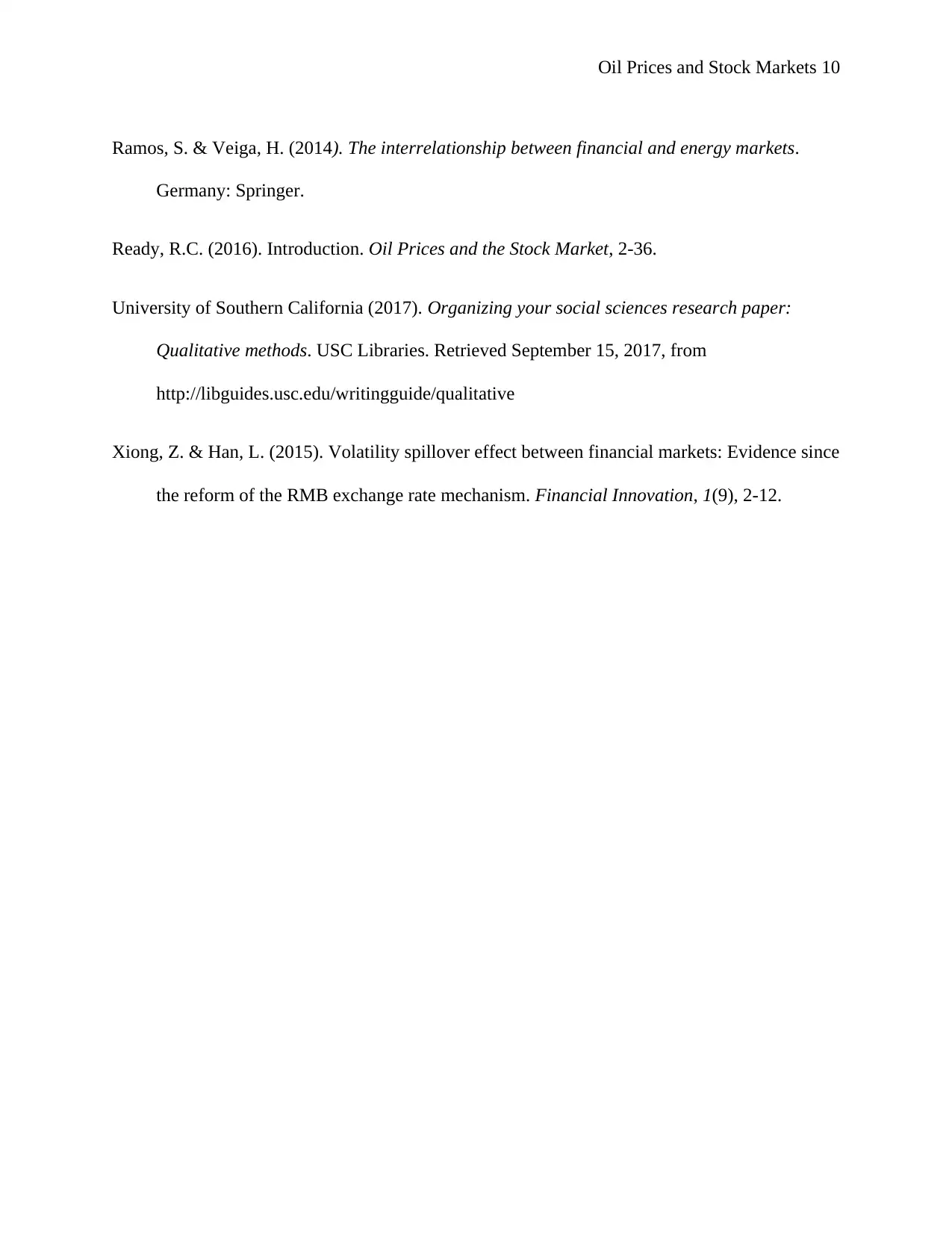
Oil Prices and Stock Markets 10
Ramos, S. & Veiga, H. (2014). The interrelationship between financial and energy markets.
Germany: Springer.
Ready, R.C. (2016). Introduction. Oil Prices and the Stock Market, 2-36.
University of Southern California (2017). Organizing your social sciences research paper:
Qualitative methods. USC Libraries. Retrieved September 15, 2017, from
http://libguides.usc.edu/writingguide/qualitative
Xiong, Z. & Han, L. (2015). Volatility spillover effect between financial markets: Evidence since
the reform of the RMB exchange rate mechanism. Financial Innovation, 1(9), 2-12.
Ramos, S. & Veiga, H. (2014). The interrelationship between financial and energy markets.
Germany: Springer.
Ready, R.C. (2016). Introduction. Oil Prices and the Stock Market, 2-36.
University of Southern California (2017). Organizing your social sciences research paper:
Qualitative methods. USC Libraries. Retrieved September 15, 2017, from
http://libguides.usc.edu/writingguide/qualitative
Xiong, Z. & Han, L. (2015). Volatility spillover effect between financial markets: Evidence since
the reform of the RMB exchange rate mechanism. Financial Innovation, 1(9), 2-12.
1 out of 10
Related Documents
Your All-in-One AI-Powered Toolkit for Academic Success.
+13062052269
info@desklib.com
Available 24*7 on WhatsApp / Email
![[object Object]](/_next/static/media/star-bottom.7253800d.svg)
Unlock your academic potential
Copyright © 2020–2025 A2Z Services. All Rights Reserved. Developed and managed by ZUCOL.





